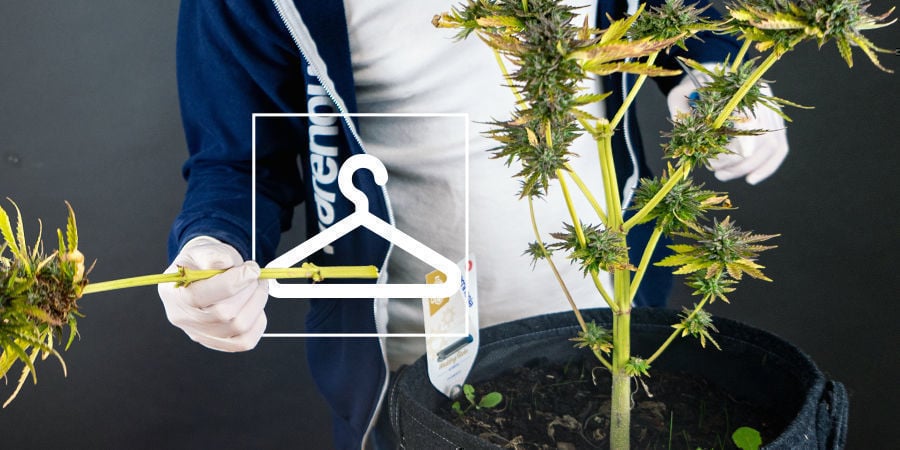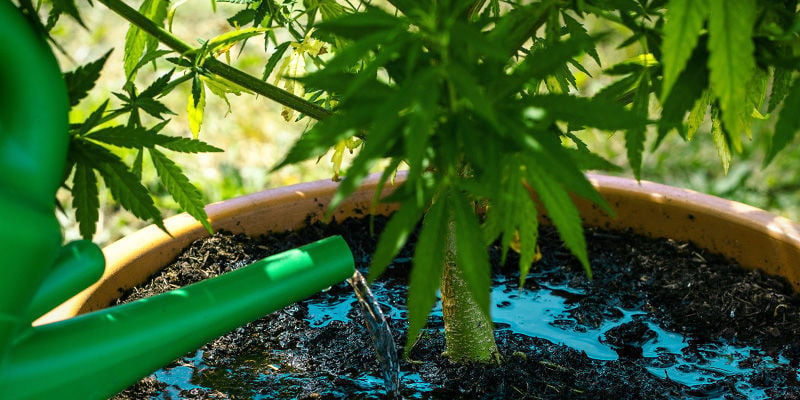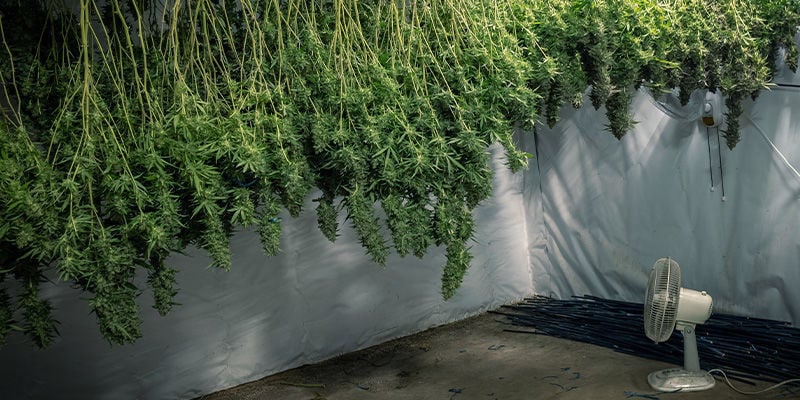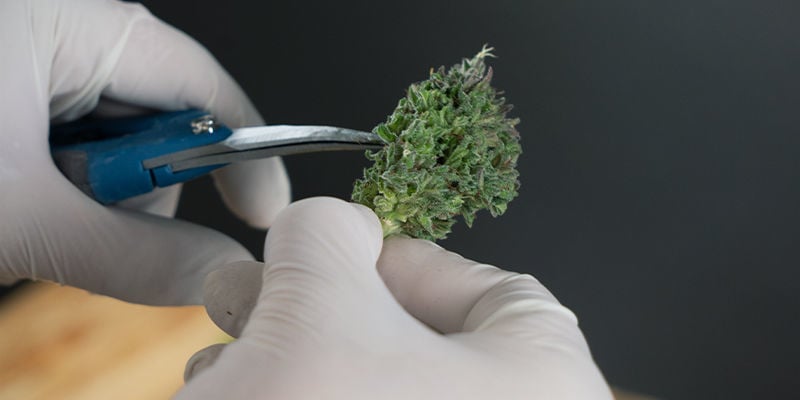How To Harvest, Dry, And Cure Your Cannabis

Harvesting, drying, trimming, and curing cannabis is the final push before you can finally smoke, vape, or otherwise consume it. Though largely less fraught with danger than the cultivation stages, there’s still opportunity for things to go wrong. Furthermore, getting everything right will bring the very best out of the buds you’ve been carefully growing for months. Make no mistake; these final stages are no less important than the others.
1. When should you harvest cannabis?
Timing your harvest right optimises the quality and potency of your yield. Do it too early, and the trichomes won’t be fully developed, meaning there will be less THC than there could be. On the other hand, leave it too long, and the THC will begin to degrade into CBN, making for a less potent and more lethargic high.
So timing is everything.
Some ways to judge harvest time are:
- By inspecting trichomes with a pocket microscope. If around 70% are milky white, then THC is at its highest level
- By inspecting the colour of the pistils (high concentration of red/brown pistils signals harvest is near)
- If many of the leaves are turning yellow (check it’s not a symptom of a problem)
- Estimating based on the strain’s supposed flowering time
2. Flush before you harvest

Although its efficacy isn’t fully understood, many growers like to “flush” their cannabis up to a week before harvest.
Flushing involves drenching the soil with many litres of pure, pH-balanced water until all the feed has been washed out. This causes the plant to use up all of the reserves it has stored within itself, rather than absorbing them from the soil.
Some think that forcing a plant to do this improves the overall flavour; others are less certain. Either way, nobody seems to think that it does any harm, and so in the pursuit of tasty weed, it’s probably worth a go!
3. Choose dry trimming or wet trimming

Before you harvest your weed, you should know whether you’re going to opt for a wet or dry trim, and prepare accordingly.
Trimming is the part of harvesting where you cut away the sugar leaves from the buds, leaving the flowers manicured and clean. As a practice, it improves overall potency (as a percentage of weight), flavour, and aesthetics.
We’ll give you an overview of how to trim shortly, but for now, let's look at some pros and cons of each.
Dry trimming:
A dry trim is our preferred method. If it goes well, it leaves you with the best-quality weed once the time comes to smoke it.
Pros:
- Buds dry more slowly, improving flavour and quality
- Not as sticky as wet trimming!
Cons:
- Takes up more space when drying, as the buds still have sugar leaves
- The higher moisture content of sugar leaves increases the chance of mould
Wet trimming:
Though a wet trim has advantages, it ultimately results in a poorer-quality smoke.
Pros:
- Takes up less space
- Buds dry quicker
- Less chance of buds going mouldy
Cons:
- Quicker drying results in drier, poorer-quality bud
- Wet trimming can be very sticky
- Though wet trimmed buds dry a little faster than dry, the manual trimming process can be much longer
4. How to prepare a drying area for cannabis

Once you’ve picked your trimming method, you’ll want to prepare your drying area. Getting the conditions right is key to achieving a top-quality final product. If it’s too hot and dry, for instance, your weed will dry up very quickly, becoming brittle and harsh. But you certainly don’t want it cold and wet either.
The optimal drying area would be:
- Dark: light destroys THC
- 20°C: this allows the weed to dry slowly
- Around 50% relative humidity
- Good airflow (use an oscillating fan if necessary)
- A good space from which to hang your buds
5. How to harvest cannabis
Harvesting weed isn’t too difficult. Nevertheless, it’s important to be careful as you do it. After months of hard work, there are still a few steps left before your bud is ready to smoke, so some focus and finesse is key.
Here’s how to harvest weed:




1. Cut any branch with buds on it at the node. The node is where one branch joins another, or joins the main stem. Before harvesting every branch, check the trichomes across the entire plant. Sometimes the buds at the top develop faster than those at the bottom, and so harvesting them a little later can be optimal.
2. Remove any fan leaves (the large multi-fingered leaves) and excess stems. Keep this leftover plant material to make cannabutter or topicals later on.
3. Decide whether to trim wet or dry. If trimming wet, now is the time to do so. Manicure your buds and hold onto any excess sugar leaves.


4. Hang your buds in your drying room. Attach string or wire to the bottom of each branch, and hang the branch and its flowers upside down. This helps to ensure even drying. Just make sure to leave enough space between each branch to maximise airflow. Leave for 10–14 days.
5. To ensure your buds are dry, bend their stems; if they snap, your buds are sufficiently dry. If they bend, too much water is still present in the plant material.
6. If you chose to go the dry trimming route, now is the time to do so.
7. Once your buds have been dried and trimmed, they are now ready to be cured.
6. How to trim cannabis

As mentioned, at some point you’ll want to trim the sugar leaves off your buds as well. And though we went through the pros and cons of trimming dry and wet, we’ll now review how to go about each process.
How to dry trim cannabis
If you dry trim, you’ll first hang and dry your flowers before trimming off the sugar leaves. So follow the drying instructions above, and when your buds have passed the “snap test”, continue to remove excess plant material. Try to remove as many of the sugar leaves as you can, but make sure you don’t snip off any of the flower material itself. Begin at the bottom of the bud and work your way up. Try to be meticulous. The fewer sugar leaves, the stronger the overall potency of your smoke, and the cleaner its taste.
But don’t throw your sugar leaves away! Though they’re nowhere near as strong as the flowers, they do still contain cannabinoids, and become much more potent when concentrated. This makes them a perfect ingredient for cannabutter and edibles.
How to wet trim cannabis
A wet trim is basically the same as a dry trim. The only difference is that you do it before you hang your buds to dry, straight after you harvest them from the plant. This process is stickier to perform, but as the sugar leaves have not curled up and dried yet, they're easier to remove. And remember to keep your wet-trimmed sugar leaves; they can still get you high!
7. How to cure cannabis buds

Once you’ve dried and trimmed your weed, there’s one final step before it’s ready for consumption: curing!
Curing is essentially a continuation of drying. Once you’ve dried your weed, it can technically be smoked. However, it will be quite harsh and the flavours won’t be so pronounced. Curing is equivalent to maturing alcohol—it improves the flavour and overall quality.
To cure weed, place it in an airtight jar. Glass mason jars tend to work very well for this job. Fill each curing jar around ¾ full with buds—you want to leave some space in order to prevent mould. Once a day, open each jar for a few minutes to allow the moist air out, and fresh air in. This is known as “burping”. Repeat this for around two weeks.
From here, many growers allow their buds to continue curing for an additional 4 weeks or so, to really maximise flavour. But after around two months total, your cured buds will be at their absolute prime. If you’re worried about reducing the likelihood of mould, consider investing in humidity packs; these will ensure the moisture content of your jars is just right.
8. Enjoy your well-earned weed

Now that you’ve grown, cared for, harvested, dried, trimmed, and cured your cannabis, there’s only one thing left to do: smoke it! At long last, your cannabis is ready to enjoy. And after all that effort, you’ve earned it.












 United States
United States







